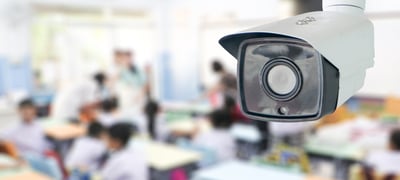Blog
How to Prepare for an Armed Intruder: Training for Schools
Of all the emergencies a school could face, shootings are by far the deadliest. As the frequency of active shooter incidents continues to rise, schools must increase safety, security, and prevention efforts.
Fortunately, there are an abundance of resources available for preparing schools to handle an active shooter incident, including drills, training, and reporting tools.
Armed Intruder Training for Schools
Prevention is the main goal of any security initiative. Along with maintaining an on-campus presence of school resource officers (SROs), training and educating students is the best method for deterring active shooting incidents in the first place. But how can school administrators ensure their training methods are effective?
Continuously train SROs on advanced techniques for identifying at-risk individuals and counseling them to prevent incidents from occurring at all. To ensure successful training, repetition is key. Train often, focusing on applying these techniques, reviewing and reflecting on past interactions, and determining how to improve future interactions for better outcomes and safer tomorrows.
Taking a holistic approach to armed intruder training is important. Along with SRO training, be sure to teach students where to go, what to do, and how to protect themselves in case of an incident—but to maximize prevention efforts, go beyond that. Provide awareness training to increase mindfulness among the student population and encourage students to speak up when they feel that they or others may be at risk.
According to a report by the Department of Education and the Secret Service, almost 100 percent of active shooters experienced or perceived a major loss before their attack; 78 percent had a history of suicide attempts or suicidal thoughts; and 71 percent felt persecuted, bullied, threatened, attacked, or injured by others prior to the incident. These are distinct red flags to watch for—and by engaging with the student population, helping them feel comfortable speaking up, and providing them with training, these red flags can be brought to the surface early on.
Improving school security and safety is not only a matter of increasing the number of SROs and other security solutions, such as software and equipment, present on campus. While those things are certainly important, increasing awareness and facilitating open communication between students and faculty are essential to early intervention, prevention, and de-escalation of incidents.
Anonymous Reporting for Prevention
In the aftermath of some recent school shootings, many people have come forward saying they felt something was "off" with the shooter—but these individuals didn't report it because, other than odd behavior, the shooter hadn't previously done anything suspicious. Some didn't report their concerns because they feared consequences, such as physical harm or damaged reputation. To alleviate concerns about retaliation or other repercussions and increase willingness to submit reports, schools should offer anonymous reporting tools for students and faculty.
Implementing the right reporting tools, however, is key to eliciting participation. Research has shown many people don't trust anonymous hotlines for reporting, despite the promise of anonymity. With today's youth being a mobile-first generation, mobile public safety apps are the most effective tool for gaining trust and increasing the frequency of reports—and subsequently reducing the likelihood of incidents. The best mobile reporting apps integrate with incident reporting software that features built-in analysis tools to provide deeper insight into incident trends, enabling schools to create a better, more-informed strategy for prevention.
Preparing for the Worst: Run, Hide, Fight
The Federal Emergency Management Agency lays out the commonly accepted protocol for an armed intruder:
- RUN: Getting away from the shooter is the top priority. Leave your things and run away. If safe to do so, warn others nearby. Call 911 when you're safe. Describe each shooter, their locations, and their weapons.
- HIDE: If you can't get away safely, find a place to hide. Get out of the shooter’s view and stay very quiet. Silence your electronic devices and make sure they won’t vibrate. Lock and block doors, close blinds, and turn off the lights. Don’t hide in group—spread out along walls or hide separately to make it more difficult for the shooter. Try to communicate with police silently—like through text messages or by putting a sign in an exterior window. Stay in place until law enforcement gives you the all clear.
- FIGHT: Your last resort when you are in immediate danger is to defend yourself. Commit to your actions and act aggressively to stop the shooter. Ambushing the shooter together with makeshift weapons such as chairs, fire extinguishers, scissors, and books can distract and disarm the shooter.
In all of the nationally-covered tragedies involving an active shooter, the number of survivors exceeds the number of lives lost; by those metrics, these techniques appear to be successful—but if even one person dies, it's too many. More needs to be done to ensure successful outcomes and safer tomorrows.
Because every school —and school district— faces different challenges, administrators need to employ a multifaceted approach to preventing and preparing for an armed intruder incident. Combine training and awareness programs, reporting technology, and knowledge to fully address your school and district's unique requirements.
Start Now: Prevent and Prepare
An investment in the tools and resources for improving school security and safety is always a good investment. Get everyone involved, including students, faculty, and parents, to increase awareness and participation in safety initiatives. Promote the new accessible, anonymous reporting tools and reward those who use them. Train often to make sure everyone knows how to react in the event of an incident. Above all, take action now to ensure your school is as prepared as possible.
More from the blog
View All Posts
How can leaders make safer healthcare environments for employees?
Read More
How to Improve School Security and Safety: The 5 Step Approach
Read More
How Reporting Tools Can Help Prevent School Violence
Read MoreSubscribe to email updates
Stay up-to-date on what's happening at this blog and get additional content about the benefits of subscribing.
